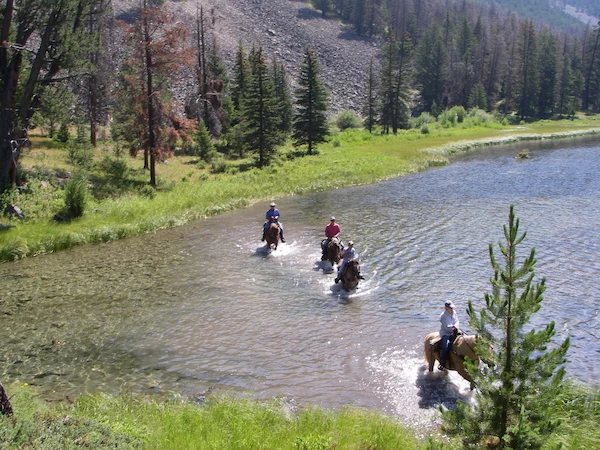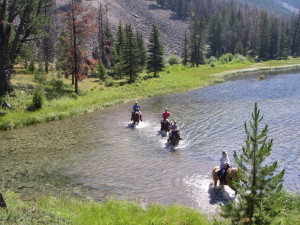Horseback Riding, Jackson Hole WY
A Note on Horses and Trail Rides at Flat Creek Ranch
Shelby Scharp, Co-Manager
Being in Wyoming conjures up all sorts of images about cowboys and horses. We hope that horseback riding on our Jackson Hole dude ranch will solidify that image. A trip to Wyoming just wouldn’t be the same without hitting the trail with a trusty steed. To make sure that you have a memory that you will enjoy, I would like to share a few horsemanship tools. With just a few pointers on attitude, language, and communication you will have a much more enjoyable time.
Horsemanship is a language, no less than English, Spanish or French. Horses do not understand very much of any verbal language. They are, however, very sensitive to attitude, position, touch and pressure. We can use this sensitivity to communicate. Your horse is always listening to ‘the language’ whether you know what messages you are sending. Attitude toward your horse will determine how you ‘get along’ with your horse. Those who are fearful, intimidated or overly aggressive are going to have a difficult time. Those who respect their horse, communicate, and work as a team will be regarded with a new friendship and a lasting memory.
Horseback riding here on our Jackson Hole dude ranch should really be called horseback driving. You are truly in the driver’s seat, not riding in the passenger seat. If you stop ‘driving’ the cruise control does not kick in and keep you going on your merry way. Likewise, I will use some common car terms to get across the language of horsemanship. The reins are the brakes asteering wheel. Your legs are used as the gas pedal.
In the saddle you should sit ‘upon’ the saddle seat, which means about the same position you would be in if you sat on a dining room chair, not sprawled or slouched as you would be in a sofa. The hips, waist, chest, shoulders, and head should be stacked in one straight line, like a stack of bricks we don’t want to fall over. If there is not at least a finger width of space between your rear and the back of the saddle, you are most likely sitting back, leaning back, or slumping, none of which is right. Your legs should hang straight down next to the horse’s side. The feet are placed in the stirrup tread at the widest part of the boot sole. To put only the toes in the stirrups will usually result in the stirrup being lost the first time the horse makes an unexpected move. If the shoes have little or no heel, a special effort must be made to keep only the sole of your foot in the stirrup. Lift your toes as high as you can without strain. Do not rely on your seat bones to carry all of your weight. Imagine a line from your head, to your waist, and heels. Finally, have a realistic expectation as far as comfort is concerned. You are going to use muscles which you don’t use on a regular basis, and they will get tired quickly.
Placing your feet in the stirrups has brought the calves either close to the horse’s ribs or resting on them. To get the horse to move forward you use the first driving aid which is to increase pressure with your whole leg. If the horse doesn’t start walking, we go to step two. Remove your calves from the horse’s sides and then bring them in with a thump against his ribs. Repeat as often as needed. Don’t do it just once and then sit there wondering if it will work. On the other hand, don’t give the horse an extra thump for good measure after he is moving. If the horse tries to stop and graze along the way, it is important to keep the forward motion going before he comes to a complete stop. As soon as the horse drops his head and slows down, apply pressure first or a thump if needed. Sometimes it is correct for children to use their heels as a primary driving aid. A child’s heels often are at the widest point on a horse’s rib cage. This is where an adult’s calves naturally lie.
Now that your horse is moving, you would like to be the one who decides where to go. The most common rein grip on our rides is one- handed. Take both the reins in your left hand just below the knot in the reins. Use your right had to adjust an even length. Don’t look at the free ends; it is the distance from your hand to the bit that needs to be even on either side. Each rein should always touch the side of the horse’s neck when riding straight forward. There should be a slight sag in the reins to allow for the natural head movement of the horse. Your left hand will be in front of the saddle horn, resting on the horse’s neck. This hand must be carried exactly over the horse’s neck with the reins adjusted to the same length. If this instruction is neglected, your horse will turn when you attempt to regulate speed. You will have asked the horse to turn; even through you didn’t mean it. Our horses primarily ‘neck rein.’ Use ‘direct reining’ only after neck reining has failed. If a left-hand turn is desired, then move your hand from the center position on the horse’s neck and put a slight stretch on the rein. Increase the tension until the horse moves his head to the left.
The reins are also used for braking. Braking is the same in horsemanship as it is in a car. You use the brakes to slow down and also to come to a complete stop. When asking your horse to slow down, take up a slight stretch on your reins and maintain pressure. Stretching the reins lightly causes the horse no discomfort, and it gently reminds him that you could cause him discomfort, and will if need be. Take a stronger stretch on the reins and hold it, if lighter pressure was completely ignored. Again, it is very important you have very little slack in your reins. If there is too much slack you will end up moving your body back in the saddle or pulling the reins up above your head. Both are very dangerous and will make you off balance. If at this point there is still no reaction, use short and rapid surges of strong pressure. Do not jerk on the reins, which will only cause your horse to throw his head. Once a response is felt (the horse is slowing down), soften the rein pressure immediately, but do not throw away the reins. If a complete halt is wanted, you will maintain the appropriate pressure until the horse has stopped. If you continue to ask for a halt after the horse has stopped, you are inadvertently asking him to back up. If you wish to back up, ask for one step backward at a time, no matter how many you want. You want the horse to be attentive to the cues you are giving him. You must also be aware of the messages you are sending.
When you arrive at the barn, you should be wearing long pants that are fitted (not baggy) and a sturdy pair of shoes. Bulky, deeply lugged soles are unsuitable for safe riding. We ask that you don’t wear a backpack or fanny pack that will interfere with how you sit in the saddle. Most saddles have saddle bags for your belongings.
On the trail there is a certain etiquette that must be recognized by everyone. Our trails are rocky and steep in places, and we don’t allow any gait other than a walk. It does not matter how much experience you have! This is for your safety and that of the other guests. I like to see long spacing between riders. This shows that each rider is paying attention and regulating his horse’s pace.
We encourage you to be a ‘quiet rider’ which means that your upper body has little movement. If you are turning back and forth to talk to people behind you, you are sending messages to your horse where you want to go. If you need to get something out of the saddle bag, bring your horse to a complete stop, then reach around for it. As I have mentioned before, being off center in the saddle is very dangerous.
We want everyone to have a good time horseback , no matter their level of experience. So enjoy a ride within your own abilities. It is my hope that the effort put into this note will make your horseback riding on our Jackson Hole dude experience a good one. Maybe it will also convince an inconsiderate rider to treat horses as people rather than objections. So in the words of one of the greatest Wyoming cowboys who ever lived:
“Sit tall in the saddle, hold your head up high,
Keep your eyes fixed where the trail meets the sky
Don’t be scared, just enjoy the ride” – Chris Ledoux
To learn more about our horseback riding on our Jackson Hole dude ranch, check out more on our activities page. We hope that you’ll join us at Flat Creek Ranch.


